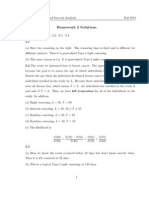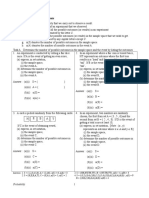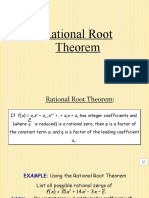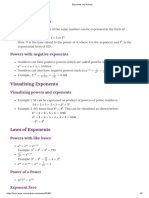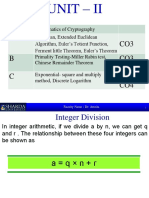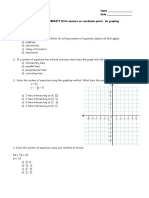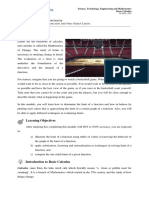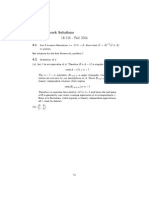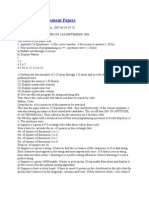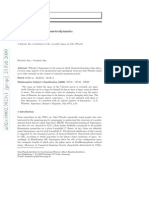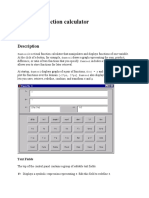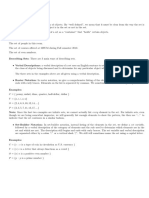Ping e On Hole Examples
Ping e On Hole Examples
Uploaded by
thermopolis3012Copyright:
Available Formats
Ping e On Hole Examples
Ping e On Hole Examples
Uploaded by
thermopolis3012Original Description:
Original Title
Copyright
Available Formats
Share this document
Did you find this document useful?
Is this content inappropriate?
Copyright:
Available Formats
Ping e On Hole Examples
Ping e On Hole Examples
Uploaded by
thermopolis3012Copyright:
Available Formats
The Pigeonhole Principle
PRINCIPLE:
If we put N + 1 or more pigeons into N pigeon holes, then at least one pigeon hole will
contain two or more pigeons.
FIRST SIMPLE EXAMPLES:
1. Among any group of 367 people, there must be at least two with the same birthday, because
there are only 366 possible birthdays.
2. Among a group of 11 people in the elevator of a 10 story building, there must be at least
two who will exit the elevator on the same oor.
3. One million trees grow in a forest. It is known that no tree has more than 600,000 leaves.
Show that at any moment there are at least two trees in the forest that have exactly the
same number of leaves.
Solution: Trees are pigeons and numbers of their leaves are pigeon holes. As there are more
pigeons than pigeon holes, there will be a pigeon hole with more than one pigeon
in it.
FURTHER EXAMPLES:
1. 12 students wrote a dictation. John Smart made 10 errors, each of the other students
made less than that number. Prove that at least two students made equal number of
errors.
Solution: Let us pretend that the students are pigeons and put them in 11 holes numbered
0, 1, 2, ... , 10, according to the number of errors made. In hole 0 we put those
students who made no errors, in hole 1 those who made exactly 1 error, in hole 2
those who made 2 errors, and so on. Certainly, hole 10 is occupied solely by John
Smart. Now apply the Pigeonhole Principle.
2. How many cards must be selected from a standard deck of 52 cards to ensure that we get
at least 3 cards of the same suit?
Solution: Since there are 4 suits, if we only select 8 cards then it is possible that we get 2
cards of each suit. So 8 is not enough to guarantee at least 3 cards of the same
suit. However, if we select 9 cards then the Pigeonhole Principle tells us that we
will get at least 9/4 = 3 cards of the same suit. So 9 is the least we can select to
guarantee at least 3 cards of the same suit.
1
3. Let A = {1, 2, 3, 4, 5, 6, 7, 8}. Prove that if ve integers are selected from A, then at least
one pair of integers have a sum of 9.
Solution: Partition the set A into 4 subsets:
{1, 8}, {2, 7}, {3, 6}, and {4, 5},
each consisting of two integers whose sum is 9. If 5 integers are selected from A,
then by the Pigeonhole Principle at least two must be from the same subset. But
then the sum of these two integers is 9.
4. A plane is colored blue and red. Is it always possible to nd two points of the same color
exactly 1 inch apart?
Solution: Think of an equilateral triangle with each side exactly 1 inch long. At least two
of its vertices have to be of the same color (colors are pigeon holes, and vertices
of the triangle are pigeons). This proves that there have to be two points of the
same color exactly 1 inch apart.
5. 51 points were placed, in an arbitrary way, into the square of side 1. Prove that some 3
of these points can be covered by a circle of radius 1/7 .
Solution: Divide the square into 25 smaller squares of side 1/5 each. Then at least one of
these small squares - holes- would contain at least three pigeons - points. Indeed,
if this is not true, then every small square contains 2 points or less; but the the
total number of points is no more that 2 25 = 50. This contradicts to the assump-
tion that we have 51 points.
Now the circle circumvented around the square with the three points inside also
contains these three points and has radius
r =
1
10
2
+
1
10
2
=
2
100
=
1
50
<
1
49
=
1
7
.
PROBLEMS:
1. Population of Greater Manchester is above 6,000,000 people, and each has no more than
100,000 hairs on his or her head. Prove that some 60 residents of Greater Manchester
have equal number of hairs.
2. There are 30 classes and 1000 students in the school. Prove that at least one class has
at least 34 students.
3. A group of 25 students wrote a dictation. John Smart made 10 errors, and each of the
2
rest made less than 10 errors. Prove that at least 3 students made equal number of errors.
4. Prove that, given any 12 natural numbers, we can chose two of them and such that their
dierence is divisible by 11.
5
. 5 points are positioned inside of the equilateral triangle of side 2. Prove that there are
two of them at the distance less than 1 from each other.
6
. Prove that of any 52 natural numbers one can nd two numbers m and n such that
either their sum m+n or their dierence mn is divisible by 100. Is the same
statement true for 51 arbitrary natural numbers?
7
. Prove that some integral power of 2 has the decimal expansion which starts with the
digits 1999:
2
n
= 1999...
3
3. A group of 25 students wrote a dictation. John Smart made 10 errors, and each of the
rest made less than 10 errors. Prove that at least 3 students made equal number of errors.
Solution: Assume that no three students made equal number of errors. It means that each
of 10 holes 0, 1, 2, 3, ... , 9 contains less than three students. Therefore all these
holes together contain less than 10 2 = 20 students. Add John Smart to this
number, and we get only 21 students, not 25 as given in the problem. We reached
a contradiction.
4. Prove that, given any 12 natural numbers, we can chose two of them and such that their
dierence is divisible by 11.
Solution: There are 11 possible remainders upon division by 11:
0, 1, 2, 3, . . . , 10.
But we have 12 numbers. if we take the remainders for holes and the numbers
for pigeons then by the Pigeonhole Principle there are at least two pigeons sharing
the same hole, i.e. two numbers with the same remainder. The dierence of these
two numbers is divisible by 11.
4
You might also like
- Homework 2 SolutionsDocument4 pagesHomework 2 Solutionsthermopolis3012No ratings yet
- ST5212 HW 1 Solution Chapter 3 SDocument4 pagesST5212 HW 1 Solution Chapter 3 Sthermopolis3012100% (1)
- Pigeonhole PrincipleDocument32 pagesPigeonhole PrincipleMary Maevelyn Maglahus100% (1)
- ICS141: Discrete Mathematics For Computer Science IDocument22 pagesICS141: Discrete Mathematics For Computer Science IMahmoud Abdel-SalamNo ratings yet
- 11.1 Intro To Sequences SeriesDocument21 pages11.1 Intro To Sequences Seriesgirisha123No ratings yet
- Mathematical Investigation (Rectangular Number Sequence)Document14 pagesMathematical Investigation (Rectangular Number Sequence)kat suNo ratings yet
- ELA Lect 1 To 35 Combine MCQ'sDocument111 pagesELA Lect 1 To 35 Combine MCQ'sIzza Shafique Izza ShafiqueNo ratings yet
- 3 Set Theory PDFDocument26 pages3 Set Theory PDFJean Marie DayaoNo ratings yet
- Infinity and Its CardinalitiesDocument88 pagesInfinity and Its CardinalitiesMohammed RazikNo ratings yet
- Linear Equation 1Document25 pagesLinear Equation 1yaw197100% (1)
- SetsDocument45 pagesSetsShruti ChandraNo ratings yet
- Department of Education: Republic of The Philippines Region IiiDocument2 pagesDepartment of Education: Republic of The Philippines Region Iiiliezl nepomuceno100% (1)
- Derivatives: Differentiation RulesDocument36 pagesDerivatives: Differentiation RulesChristine EvangelistaNo ratings yet
- CH 6Document10 pagesCH 6Sravan Kumar JanamaddiNo ratings yet
- Principle of Mathematical InductionDocument11 pagesPrinciple of Mathematical InductionAnirvan Shukla100% (1)
- The Pigeonhole PrincipleDocument16 pagesThe Pigeonhole PrincipleHarjotSinghNo ratings yet
- Digit ProblemsDocument3 pagesDigit ProblemsThea PadillaNo ratings yet
- Sets and SubsetsDocument11 pagesSets and Subsetsyaoi yuriNo ratings yet
- Convex Optimization With Engineering ApplicationsDocument38 pagesConvex Optimization With Engineering ApplicationsErin Fox100% (1)
- 2.3. Venn Diagrams & Set OperationsDocument10 pages2.3. Venn Diagrams & Set OperationsJestin ManaloNo ratings yet
- Pigeonhole PrincipleDocument2 pagesPigeonhole PrincipleZubayr MoroNo ratings yet
- Rational Function IntroductionDocument23 pagesRational Function IntroductionUddin NimatNo ratings yet
- Tutorial-Set Theory PDFDocument4 pagesTutorial-Set Theory PDFaryan pareekNo ratings yet
- Detail Lesson PlanDocument14 pagesDetail Lesson Planmaffy fernandezNo ratings yet
- Math 10 - Lesson 1 - Sequence and SeriesDocument40 pagesMath 10 - Lesson 1 - Sequence and SeriesCleopatra0% (1)
- Rational NumbersDocument18 pagesRational NumbersZypherGiestNo ratings yet
- GROUPS, Subgroups and Cyclic GroupsDocument84 pagesGROUPS, Subgroups and Cyclic GroupsCristine Castulo PreguntaNo ratings yet
- The Chinese Remainder TheoremDocument8 pagesThe Chinese Remainder TheoremjamofreyNo ratings yet
- Probability 7.1.1 Sample Space and Events: H E B A TDocument14 pagesProbability 7.1.1 Sample Space and Events: H E B A TbenjoeNo ratings yet
- Remainder TheoremDocument3 pagesRemainder TheoremMax EeNo ratings yet
- Central Tendency + DispersionDocument28 pagesCentral Tendency + Dispersionneha.akshiNo ratings yet
- Statistics Lesson Plan Residual Plots FinalDocument7 pagesStatistics Lesson Plan Residual Plots Finalapi-482776194No ratings yet
- Rational Zero TheoremDocument9 pagesRational Zero TheoremPrecious Kim Pascua SamboNo ratings yet
- The Elimination Method Guided NotesDocument3 pagesThe Elimination Method Guided Notesapi-450522734100% (1)
- Non Routine Problems Involving Rational NumbersDocument5 pagesNon Routine Problems Involving Rational NumbersVekram KrishnanNo ratings yet
- Exponents and Powers NotesDocument2 pagesExponents and Powers NotesMidhun Bhuvanesh.B 7ANo ratings yet
- College and Advance Algebra MODULE 4Document6 pagesCollege and Advance Algebra MODULE 4Jefferson SociasNo ratings yet
- P1-Set TheoryDocument41 pagesP1-Set TheoryDipanwita DebnathNo ratings yet
- Applications of Pigeonhole PrincipleDocument19 pagesApplications of Pigeonhole PrincipletruoccuocdoiNo ratings yet
- Counting Sample PointsDocument22 pagesCounting Sample PointsReinaNo ratings yet
- IPLANDocument6 pagesIPLAN19 Juvelyn OmpocNo ratings yet
- LP Class 9Document15 pagesLP Class 9Radhika Singh100% (1)
- The Pigeonhole PrincipleDocument2 pagesThe Pigeonhole PrincipleEdmund RufinoNo ratings yet
- Pythagorean TriplesDocument3 pagesPythagorean TriplestlcpinedaNo ratings yet
- Vector Spaces WorksheetDocument13 pagesVector Spaces WorksheetMuthuPabasaraNo ratings yet
- Solving System of Linear Equations Unit Plan TemplateDocument6 pagesSolving System of Linear Equations Unit Plan Templateapi-351781754No ratings yet
- Introduction To Probability PPT 1 FinalDocument71 pagesIntroduction To Probability PPT 1 FinalNikoli MajorNo ratings yet
- UNIT - II (Part 1)Document63 pagesUNIT - II (Part 1)asdadsaNo ratings yet
- Systems of Equations Assessment REVIEWDocument5 pagesSystems of Equations Assessment REVIEWdevikaNo ratings yet
- LP - MATH Gr7 Lesson4 Absolute Value and Number Line IDocument5 pagesLP - MATH Gr7 Lesson4 Absolute Value and Number Line ISarah AgunatNo ratings yet
- Methods of ProofDocument14 pagesMethods of ProofMahnoor AslamNo ratings yet
- Rational Numbers: Pre-RequisitesDocument74 pagesRational Numbers: Pre-RequisitesBestowal Infotechs 2018No ratings yet
- Graph Theory II - AnswersDocument8 pagesGraph Theory II - AnswerskheyNo ratings yet
- Modular ArithmeticDocument30 pagesModular ArithmeticJoliane Reblora100% (2)
- Lesson1 3-EuclideanAlgorithm&DiophantineEquationDocument24 pagesLesson1 3-EuclideanAlgorithm&DiophantineEquationEly Balaquiao IVNo ratings yet
- Study Guide 1.1 - Limit of A Function and One-Sided LimitsDocument14 pagesStudy Guide 1.1 - Limit of A Function and One-Sided LimitsEna CharmagneNo ratings yet
- SL Bivariate Analysis QuestionsDocument15 pagesSL Bivariate Analysis Questionsmichellec24No ratings yet
- Day 2 - Permutations and CombinationsDocument39 pagesDay 2 - Permutations and CombinationsJanice Reyes HermanoNo ratings yet
- Pigeonhole PrincipleDocument0 pagesPigeonhole PrincipleMarco CollantesNo ratings yet
- Math 4575: HW #2Document4 pagesMath 4575: HW #2poncoNo ratings yet
- Discrete 12-03-17 IntroDocument3 pagesDiscrete 12-03-17 IntrobirahmanialtafNo ratings yet
- Pigeon Hole PrincipleDocument4 pagesPigeon Hole Principlesssamant100% (1)
- Linear Algebra NotesDocument1 pageLinear Algebra Notesthermopolis3012No ratings yet
- Patient ChargesDocument13 pagesPatient Chargesthermopolis3012No ratings yet
- Numerical Linear AlgebraDocument2 pagesNumerical Linear Algebrathermopolis3012No ratings yet
- Proportion Word ProblemsDocument4 pagesProportion Word Problemsthermopolis3012No ratings yet
- Assignment OneDocument8 pagesAssignment Onethermopolis3012No ratings yet
- Partial Solutions Tre Fen ThenDocument1 pagePartial Solutions Tre Fen Thenthermopolis3012No ratings yet
- 6 Homework Solutions 18.335 - Fall 2004: 6.1 A A A (I A) (I + A)Document1 page6 Homework Solutions 18.335 - Fall 2004: 6.1 A A A (I A) (I + A)thermopolis3012No ratings yet
- MA251 Computer Assessment: "Survival Analysis" Answer Key: The Saylor Foundation Page 1 of 1Document1 pageMA251 Computer Assessment: "Survival Analysis" Answer Key: The Saylor Foundation Page 1 of 1thermopolis3012No ratings yet
- 7 Homework Solutions 18.335 - Fall 2004: 7.1 100 100 H 1 (I + J 1) C (I J) 1 (X +y) C (X X) (Y Y) (X +y) HDocument1 page7 Homework Solutions 18.335 - Fall 2004: 7.1 100 100 H 1 (I + J 1) C (I J) 1 (X +y) C (X X) (Y Y) (X +y) Hthermopolis3012No ratings yet
- PS6 SolutionDocument1 pagePS6 Solutionthermopolis3012No ratings yet
- Real Number DoneDocument38 pagesReal Number DoneISHAAN GOYAL100% (1)
- Math221: HW# 2 Solutions: Andy Royston October 12, 2005Document12 pagesMath221: HW# 2 Solutions: Andy Royston October 12, 2005Zahid KumailNo ratings yet
- Add Subtract and Multiply MatricesDocument11 pagesAdd Subtract and Multiply MatricesCesar Puga CamposNo ratings yet
- Nagarro Question Papers 96Document5 pagesNagarro Question Papers 96akhiles!No ratings yet
- Divergence of A Vector Point FunctionDocument5 pagesDivergence of A Vector Point FunctionRakhi KhandelwalNo ratings yet
- Branch&Bound MIPDocument35 pagesBranch&Bound MIPperplexeNo ratings yet
- Fractional CalculusDocument28 pagesFractional Calculusapi-26870484No ratings yet
- Operations Scheduling: Advanced Operations Management Dr. Ron Tibben-Lembke CH 16: 539-544Document49 pagesOperations Scheduling: Advanced Operations Management Dr. Ron Tibben-Lembke CH 16: 539-544mukund kaulNo ratings yet
- Unit 1Document27 pagesUnit 1Ñávîñ Dêvâñ JüstërNo ratings yet
- The Superspace of Geometrodynamics: Received: Date / Accepted: DateDocument31 pagesThe Superspace of Geometrodynamics: Received: Date / Accepted: DateCassandra Torrescano SolísNo ratings yet
- Diffusion Gaussian Kernel PDFDocument13 pagesDiffusion Gaussian Kernel PDFfpttmmNo ratings yet
- Ols ProofDocument2 pagesOls ProofNopri Keliat100% (1)
- Presentation - Spatial Organization and Spatial Relationship PDFDocument17 pagesPresentation - Spatial Organization and Spatial Relationship PDFGokulNo ratings yet
- Test Preparation For Honors Precalculus Final ExamDocument1 pageTest Preparation For Honors Precalculus Final ExamPegsNo ratings yet
- Logistique Et Distribution: The Facility Location ProblemDocument43 pagesLogistique Et Distribution: The Facility Location ProblemgillesNo ratings yet
- Transformation of ShapesDocument19 pagesTransformation of Shapesbluesn0002No ratings yet
- Funtool - Function Calculator: SyntaxDocument3 pagesFuntool - Function Calculator: SyntaxMariglen KurtiNo ratings yet
- CCSS Algebra Concept Organizer - 10!3!13Document5 pagesCCSS Algebra Concept Organizer - 10!3!13rcarteagaNo ratings yet
- Fourier Transform and Plancherel TheoremDocument34 pagesFourier Transform and Plancherel Theoremgogo222No ratings yet
- EnglishDocument19 pagesEnglishmarmaduke32No ratings yet
- 3 Ways of Describing A SeTDocument2 pages3 Ways of Describing A SeTZach RomeroNo ratings yet
- RMC2006Document97 pagesRMC2006calinenescu100% (1)
- MATLAB 2023b MathematicsDocument830 pagesMATLAB 2023b Mathematicsdo.dinh.khaiNo ratings yet
- Complex Representation of Harmonic OscillationsDocument16 pagesComplex Representation of Harmonic OscillationsCan EroğluNo ratings yet
- 2024 Mathematics GR 12 Term 2 RevisionDocument38 pages2024 Mathematics GR 12 Term 2 Revisionnaidoojayshree903No ratings yet
- Mathematics 07L Integral Calculus Differential EquationsDocument1 pageMathematics 07L Integral Calculus Differential Equationsjake luis matthewNo ratings yet
- Chapter 2 - FunctionsDocument47 pagesChapter 2 - FunctionsAhmed DammakNo ratings yet
- 2015 SMJK Chung Ling BW P2 (Trial)Document4 pages2015 SMJK Chung Ling BW P2 (Trial)Chris Emmanuel Nathan100% (1)
- Chap 3 Weighted Residual and Energy Method For 1D Problems: Finite Element Analysis and Design Nam-Ho KimDocument47 pagesChap 3 Weighted Residual and Energy Method For 1D Problems: Finite Element Analysis and Design Nam-Ho KimNarendra KulkarniNo ratings yet
- Quiz Arithemtic and GEometricDocument2 pagesQuiz Arithemtic and GEometricKier Wen LitaNo ratings yet
